TEAM TIP
Reinforcing loops can create momentum in either an advantageous or a detrimental direction. Look for harmful loops at work in your setting that might be beneficial if you could reverse their course — these represent high-potential leverage points.
What circumstances lead to seemingly sudden changes? I’ve recently read several books that, while different on the surface, all look at the dynamics of change. The books are: The Tipping Point: How Little Things Can Make a Big Difference by Malcolm Gladwell (Back Bay Books, 2002); Guns, Germs and Steel: The Fates of Human Societies by Jared M. Diamond (W. W. Norton & Company, 1997); An Inconvenient Truth: The Planetary Emergency of Global Warming and What We Can Do About It by Al Gore (Rodale Books, 2006).
As we shall see, although the titles cover a wide set of issues and timeframes — from the rise and fall of pop culture fads (Gladwell) to a complete history of human societies (Diamond) to the current challenge of climate change (Gore) — in every case, the notion of reinforcing feedback sheds light on the change process and how it often seems to arrive suddenly, dramatically, and mercilessly.
The Power of Buzz
In his bestselling book, The Tipping Point, Malcolm Gladwell details several relatively simple cases to describe his “tipping point” concept — the sudden appearance of a social phenomenon.
He likens pop culture fads such as the resurgence in popularity of the Hush Puppies brand shoes and the emergence of “Ya-Ya Sisterhood” reading groups to viral epidemics, in fact, calling them “social epidemics.” The basic idea is rather simple: Under the right circumstances, a social phenomenon gains enough momentum that it begins to generate a kind of pop culture buzz that further adds to its momentum.
A simple representative of this dynamic is depicted below. Starting at the top, as the number of “Total Followers” for a given fad grows (e.g., the number of people wearing Hush Puppies shoes), “Awareness” of the fad grows. This consciousness attracts “New Followers,” who join the previously established base of “Total Followers.” But this is not a one-time event; it is actually an ongoing, continuously evolving process: “Awareness” is constantly building, and “New Followers” are constantly being added.
New Followers Awareness
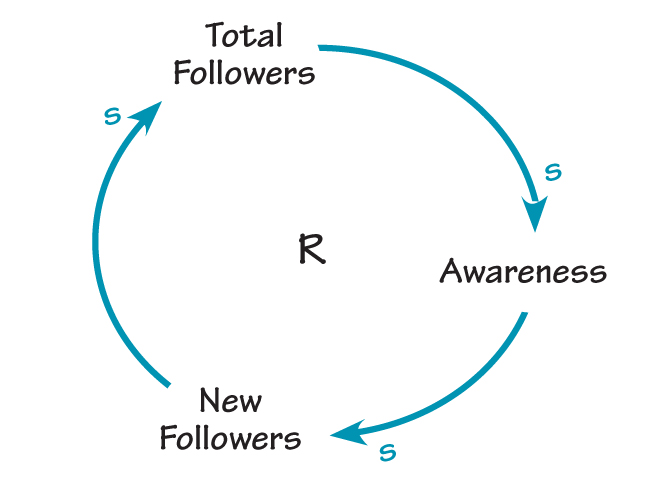
Not all fads result in sudden shifts. The critical factor is the speed with which this reinforcing loop builds momentum, a characteristic that depends on the strength of every causal link in the loop. For example, if followers are very vocal about their participation in the fad (exemplified by a Hush Puppies wearer announcing proudly, “Hey, look at my new‘ kicks’!”), then the connection from, “Total Followers” to “Awareness” is strong. If all the links in a reinforcing loop are strong, then the fad has the potential to build momentum, often with startling speed.
According to Gladwell, “The success of any kind of social epidemic is heavily dependent on the involvement of people with a particular and rare set of social gifts.” He breaks them into three types: Connectors, Mavens, and Salesmen. Connectors are high-value connection nodes in a social network; they are people who are not only in contact with a lot of people, but more important, with a lot of different kinds of people, from different social circles. Clearly, the involvement of a Connector in a social epidemic significantly strengthens the spread of the fad.
Mavens are those with deep expertise in a particular area. They typically serve to lend legitimacy to the phenomenon, especially in its early stages. Finally, Salesmen are people who win other people over to their ideas. Social epidemics benefit from having somebody out there who is good at convincing others to join in. They are the ones who make it “cool” to wear the retro shoes, and they strengthen the power of the reinforcing loop by doing so.
The Seeds of Advantage
Jared Diamond’s research and analysis center on the development, expansion, and ultimate dominance of agriculture-based society across the planet. His investigation began with a fundamental question: Why did the Europeans’ diseases wipe out the Native American peoples and not the other way around? Even though his questions are starkly different from those of Gladwell, there are remarkable similarities in terms of the structure of the stories. Specifically, across a variety of settings over the course of human history, the often dramatic developments of the last 10,000 years can be better understood through an identification of the underlying reinforcing feedback processes.
Prior to the Agricultural Revolution, human populations were limited by the natural carrying capacity of the territory occupied by what were then hunter-gatherer societies. The domestication of plants alleviated a major constraint on the population of societies. The population booms that followed triggered explosive growth in “guns, germs, and steel”—the weaponry, cohabitant microbes and therefore the immune systems, and technology of agriculturalist societies. With this growth backing them, the agriculturalists inevitably replaced other societies whenever and wherever they met.
The first step in the process was a population explosion. Freed from the limitations of natural food capacity, agriculturalist populations quickly grew to levels unseen among the ranks of hunter-gatherer tribes. In retrospect, we can see that generating food surpluses conferred profound and long-lasting benefits to the agrarian societies.
Food Surpluses New Territories
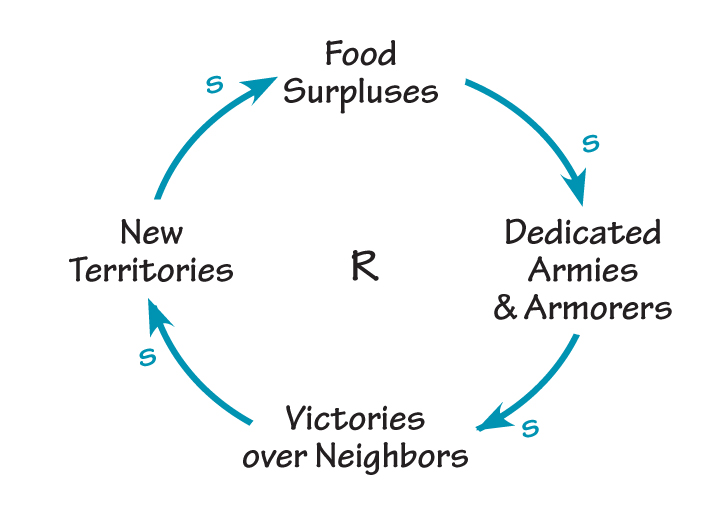
Guns. For instance, Diamond describes how food surpluses arising from the shift to agriculture increased the capability of societies to wage war. In a conflict with a pre-agrarian society, food surpluses gave the agricultural society tremendous advantages in terms of both how many people they could send into battle and how long they could keep them there. Eventually, the existence of food surpluses enabled some people to take themselves out of food production entirely in order to build their combat skills and technology — and the warrior class was born. The emergence of this warrior class further contributed to the imbalance between the war-making capabilities of agrarian and pre-agrarian societies. The emergence of a warrior class (shown below, left) is another example of a positive feedback loop — one where, over time, the loop builds up tremendous “momentum.” This virtuous cycle, in which advantage created still greater advantage, shows up in several different forms in the storyline behind Diamond’s “Guns” section.
Steel. Diamond uses “Steel” to symbolize technology in general and the benefit it afforded the Europeans over the Native Americans in particular. Just as food surpluses released a portion of the population from the daily production of food so they could dedicate themselves to the development of weapons and warriors, it also freed some people to develop technology. In fact, in certain ways, it demanded it: Mastering the art of using a forge to correctly shape a plow required concerted effort. So once again, we can identify a virtuous cycle at work behind the ever-growing advantage that technology bestows on agricultural societies. However, “the development and reception of inventions vary enormously from society to society”; societies that were receptive to technological innovation generally fared better than those that were unduly conservative.
Dedicated Technologists Victories over Neighbors
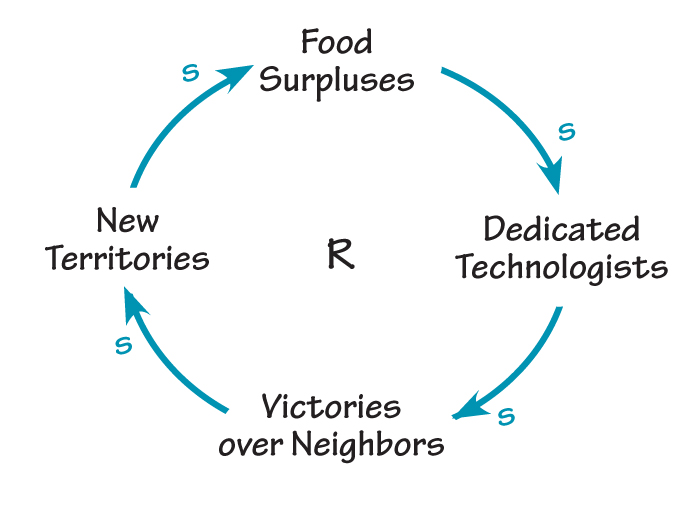
Germs. According to Diamond, “Far more Native Americans died in bed from Eurasian germs than on the battlefield from European guns and swords.” While the development of guns and steel were intentional societal strategies, the development of “Germs” was not. Instead, the germs advantage was the unintended consequence of other trends associated with the growing agrarian societies. In particular, Diamond points out that agrarian people’s regular and close proximity to domesticated animals created opportunities for germs to make the evolutionary leap from animal to human host. And because these people were living in ever-greater densities, any germ that made the leap quickly spread throughout the entire society.
Diamond further argues that the advantage that the European/Asian people had over the Americans can be traced back to the natural “endowments” that each region afforded its populations. Whereas Eurasia presented societies with a wide range of domesticable plants (to launch the Agricultural Revolution) and animals (to strengthen immune systems), the Americas offered relatively few of both to its inhabitants, and so correspondingly left them at a disadvantage when the two hemispheres collided.
Of course, the key drivers to disease resistance (“Exposure to Domesticated Animals” and “Population Density”) are themselves linked to powerful self-reinforcing loops. Several key processes related to economic growth ensure that, as population density grows, economic activity grows, further promoting an increase in population density. Similarly, as “Exposure to Domesticated Animals” grows, economic success follows, which encourages the expansion of animal holdings and leads to additional “Exposure to Domesticated Animals.”
Natural Endowments Population Density
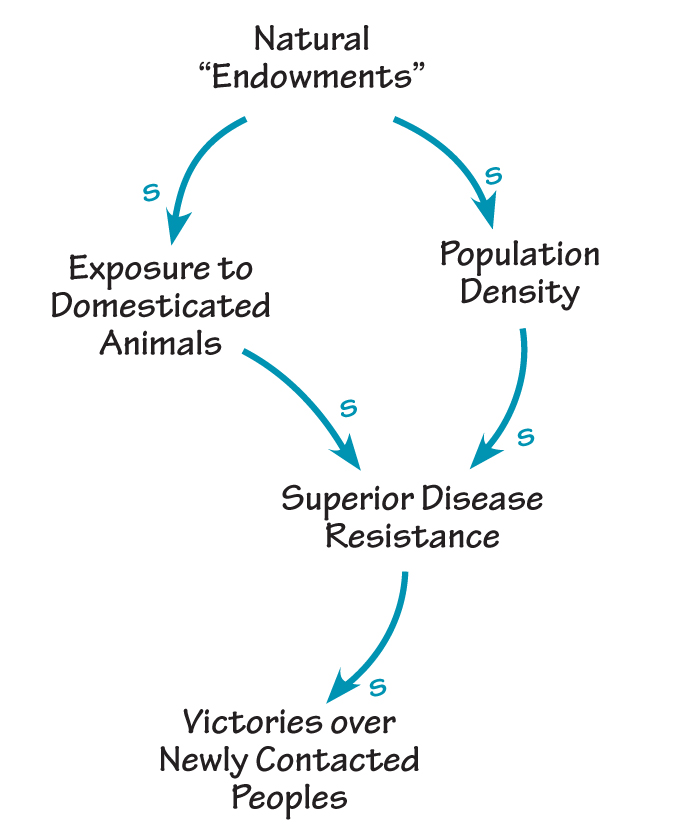
These unintended consequences further exacerbated the self-reinforcing loop that was driving the growing dominance of the agricultural European/ Asian societies. In fact, one can easily see that to the extent that germs contributed to the victory of Europeans over Native Americans, they by proxy then contributed to the flow of wealth created as Europeans tapped into American resources. This, in turn, led to the continued growth of European economies and cities, which further contributed to the population density of European societies. The notion that unintended consequences can trigger dynamics unto themselves is an important one when one examines the security threat associated with climate change.
Unintended Consequences of Industrialization
The story of climate change is another example of unintended consequences. The Industrial Revolution enabled a period of economic growth never before seen in human societies. This growth can be viewed as yet another case of reinforcing feedback. Industrial activity, in particular the building of new economic “capital” (i.e., the means of production), adds to a society’s economic base, which then allows for even more industrial activity in future periods. This positive feedback created the exponential growth associated with industrialization and the dramatic increases in wealth and standards of living for societies that industrialized.
Economic Capital Base Industrial
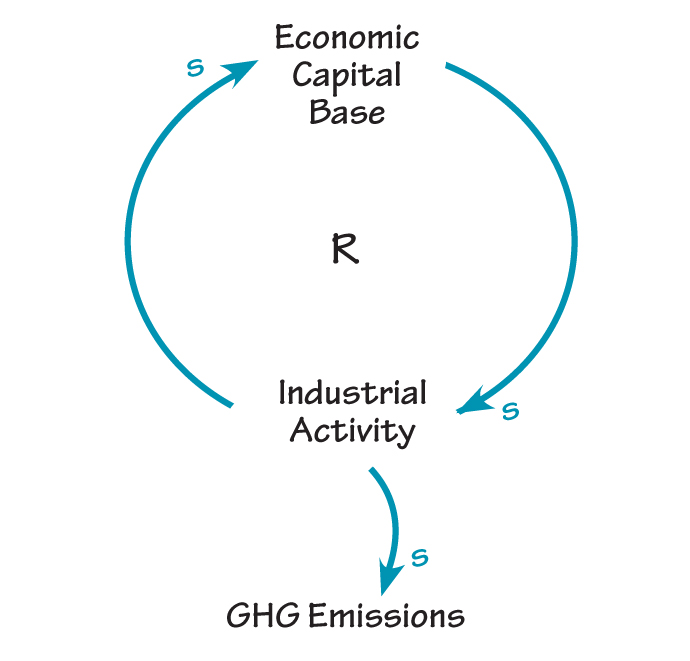
What was unseen until recently, however, was the unintended side-effect of that economic activity. For 200 years, industrial activity has been generating emissions of greenhouse gases. And there is now a broad scientific consensus that the accumulation of these gases is having measurable effects on the global climate.
While continued exponential growth in the volume of GHGs generated through unchecked industrial activity is already a serious concern, some scientists are even more concerned about the potential for one or more tipping points. The climate system is itself a set of interconnected subsystems, each of which is incredibly complex on its own. As a result, even the best scientists acknowledge that it is difficult to predict precisely what will happen as average temperatures rise around the globe.
One of the chief concerns is related to the polar ice caps. According to Al Gore in An Inconvenient Truth, “Since the 1970s, the extent and thickness of the Arctic ice cap has diminished precipitously.” The Greenland and Antarctic ice sheets have been similarly affected. This reduction in polar ice is believed to be one of the primary causes for the already measurable increase in sea level, which is a major cause of concern for islands and low-lying countries.
But even people living at higher elevations need to be concerned about shrinking polar ice, if at some point it triggers a powerful reinforcing loop. As Gore describes, polar ice reflects a significant amount of solar radiation. The concern is that, as the polar ice melts from rising global temperatures, the caps will reflect less solar radiation. This will in turn raise temperatures further, which would reduce the polar ice caps even more. The net effect is that, similar to one of Gladwell’s social epidemics, temperature increases could gain momentum of their own, resulting in a sudden and dramatic rise.
Ice caps are not the only source of a potential tipping point. Other climatic subsystems (e.g., the system of deep ocean currents) could have their own reinforcing loops that accelerate change once change starts to occur. The current forecasts of a 4.8-degree Celsius temperature increase by the end of this century do not include the effects of these tipping points. So if they are present and they become active, then the 4.8-degree increase could turn out to be a substantial underestimate of the actual temperature change experienced.
Emissions Atmosphere Global Temperature
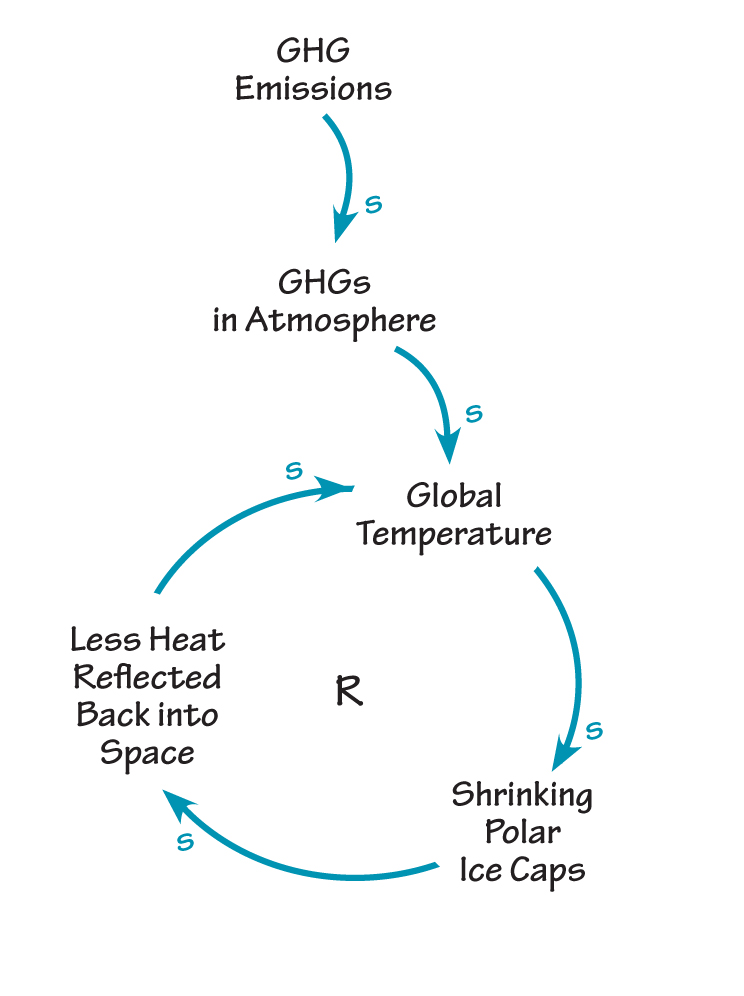
Recognizing Patterns
Seventeen years ago, shortly after I joined my first consulting firm, a founding partner explained to a small group of new hires that one of the most advanced skills a consultant develops is “pattern recognition.” Pattern recognition is what gives the consultant the ability to take a lesson from one setting and apply it to another, and it is what enables her to distinguish between core strategic concerns and distractions. I immediately realized that systems thinking supports the development of this skill.
The three books discussed here are applications of this idea. They describe important shifts in three different systems that share an underlying pattern: Each system is driven by a reinforcing feedback loop. The presence of a loop is the essential architecture that determines whether a system disturbance remains a one-off change or becomes a true, ongoing transformation.
Even the existence of a feedback process doesn’t guarantee that the shift is going to arrive suddenly, dramatically, and mercilessly — the kind of thing that often characterizes core strategic concerns (and inspires authors to write books). Some reinforcing loops are so weak that they don’t have a noticeable impact on a system’s overall behavior. This second aspect of pattern recognition calls for a dissection of the reinforcing loop to evaluate the likely strength of each and every link. Ultimately, I believe that the discipline of computer simulation is vital to understanding a system’s behavior and developing recommendations. But causal loops, such as the ones used in this article, can provide insight into the basic underlying architecture of the problem.
